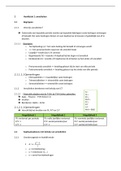LABOUR AND TRADE UNIONS FULL NOTES
Gilded Era
- Development of labour and union rights however progress was limited or non-
existent with the government being reluctant to interfere (Laizess Faire)
- Unions had no legal recognition so workers had no representation or protection –
this allowed employers to exploit their workers
o There was no legislation protecting the civil rights of workers – hours were
long and no health or safety insurance
o Child labour still existed in cotton mills and mines
- Between 1860-1900, the number of industrial workers increased from 885,000 to
3.2 million as the US became more industrialised more people working in
manufacturing and factories
- Majority of new (immigrant) workers were unskilled or semi-skilled this made
them easier to replace and were willing to work for less
- A lot of contract work which left no stability for workers
-
Unions in the late 19th Century and early 20th Century
- Most successful attempts at union protection in 1865 were amongst the specialised
craft unions – Craft labour = Highly skilled labourer who has specific training and can
command high wages and better working conditions
o If you were more skilled, you were less replaceable so, in turn, could demand
higher wages
Knights of Labour (KOL) 1869
- Led by Uriah Stephens and Terence Powderly
-
- Aimed to unite all skilled and unskilled workers, remove racial and cultural barriers
o Potentially made the union less effective because it was a mix of different
professions and spread all over the country
- Welcomed women
- Demanded 8-hour days, equal pay and the abolition of child labour
- Initially, they rejected striking and focused on going to a federal level and getting
legislation.
- 1881 = 20,000 1886 = 700,000
- In 1885, changed tactics after Jay Gould (owner of a railroad) launched an anti-union
campaign leading to the KOL striking – was successful and boosted membership
o Of the 700,000 members, 10,000 were women and 50,000 were AAs
- Membership fell to 100,000 after the Haymarket Affair 1886
, Haymarket Affair 1886
- Violence broke out between police and striking workers in Chicago
o 4 workers killed
- Led to a protest in Haymarket Square in the city about the treatment of strikers by
police - a bomb was thrown into the rally which killed 7 policemen
o The police open fire into the crown killing 4 workers
o Violence was blamed on two German men (FOREIGNERS) – Foreigners often
used as scapegoats for violence and disruption in the US
o 8 people arrested and 5 executed – set an example to other workers and
strikers
- Led to a fall in membership in unions
American Federation of Labour 1886
- Replaced the KOL
- Led by Samuel Gompers – was effective at talking to bosses and negotiating
- 1914 = 2 million members
The Industrial Workers of the World (Wobblies) 1905
- Set up in Chicago
- A militant organisation with a reputation for violence – focused on the poor and
illiterate
- Membership peaked in 1923 but fell apart in 1924 over disputes over methods –
violence put people off
- Lack of unity weakened them
o Racism = former slaves not welcomed as they threatened the white
monopoly in the workplace
o Divisions made it harder to exert force on employers
The ‘Robber Barons’ and ultra-wealthy
- The government’s laissez-faire attitude resulted in the creation of a few individuals
gaining a monopoly on a product and market big, supernormal profits
o They were able to exploit workers and pay low wages as there was no
legislation or rules stopping them
o Egs: Rockefeller (oil), Carnegie (Steel), Vanderbilt (Shipping and railroads)
o They also had influence with Presidents so things got ignored
Gilded Era
- Development of labour and union rights however progress was limited or non-
existent with the government being reluctant to interfere (Laizess Faire)
- Unions had no legal recognition so workers had no representation or protection –
this allowed employers to exploit their workers
o There was no legislation protecting the civil rights of workers – hours were
long and no health or safety insurance
o Child labour still existed in cotton mills and mines
- Between 1860-1900, the number of industrial workers increased from 885,000 to
3.2 million as the US became more industrialised more people working in
manufacturing and factories
- Majority of new (immigrant) workers were unskilled or semi-skilled this made
them easier to replace and were willing to work for less
- A lot of contract work which left no stability for workers
-
Unions in the late 19th Century and early 20th Century
- Most successful attempts at union protection in 1865 were amongst the specialised
craft unions – Craft labour = Highly skilled labourer who has specific training and can
command high wages and better working conditions
o If you were more skilled, you were less replaceable so, in turn, could demand
higher wages
Knights of Labour (KOL) 1869
- Led by Uriah Stephens and Terence Powderly
-
- Aimed to unite all skilled and unskilled workers, remove racial and cultural barriers
o Potentially made the union less effective because it was a mix of different
professions and spread all over the country
- Welcomed women
- Demanded 8-hour days, equal pay and the abolition of child labour
- Initially, they rejected striking and focused on going to a federal level and getting
legislation.
- 1881 = 20,000 1886 = 700,000
- In 1885, changed tactics after Jay Gould (owner of a railroad) launched an anti-union
campaign leading to the KOL striking – was successful and boosted membership
o Of the 700,000 members, 10,000 were women and 50,000 were AAs
- Membership fell to 100,000 after the Haymarket Affair 1886
, Haymarket Affair 1886
- Violence broke out between police and striking workers in Chicago
o 4 workers killed
- Led to a protest in Haymarket Square in the city about the treatment of strikers by
police - a bomb was thrown into the rally which killed 7 policemen
o The police open fire into the crown killing 4 workers
o Violence was blamed on two German men (FOREIGNERS) – Foreigners often
used as scapegoats for violence and disruption in the US
o 8 people arrested and 5 executed – set an example to other workers and
strikers
- Led to a fall in membership in unions
American Federation of Labour 1886
- Replaced the KOL
- Led by Samuel Gompers – was effective at talking to bosses and negotiating
- 1914 = 2 million members
The Industrial Workers of the World (Wobblies) 1905
- Set up in Chicago
- A militant organisation with a reputation for violence – focused on the poor and
illiterate
- Membership peaked in 1923 but fell apart in 1924 over disputes over methods –
violence put people off
- Lack of unity weakened them
o Racism = former slaves not welcomed as they threatened the white
monopoly in the workplace
o Divisions made it harder to exert force on employers
The ‘Robber Barons’ and ultra-wealthy
- The government’s laissez-faire attitude resulted in the creation of a few individuals
gaining a monopoly on a product and market big, supernormal profits
o They were able to exploit workers and pay low wages as there was no
legislation or rules stopping them
o Egs: Rockefeller (oil), Carnegie (Steel), Vanderbilt (Shipping and railroads)
o They also had influence with Presidents so things got ignored










